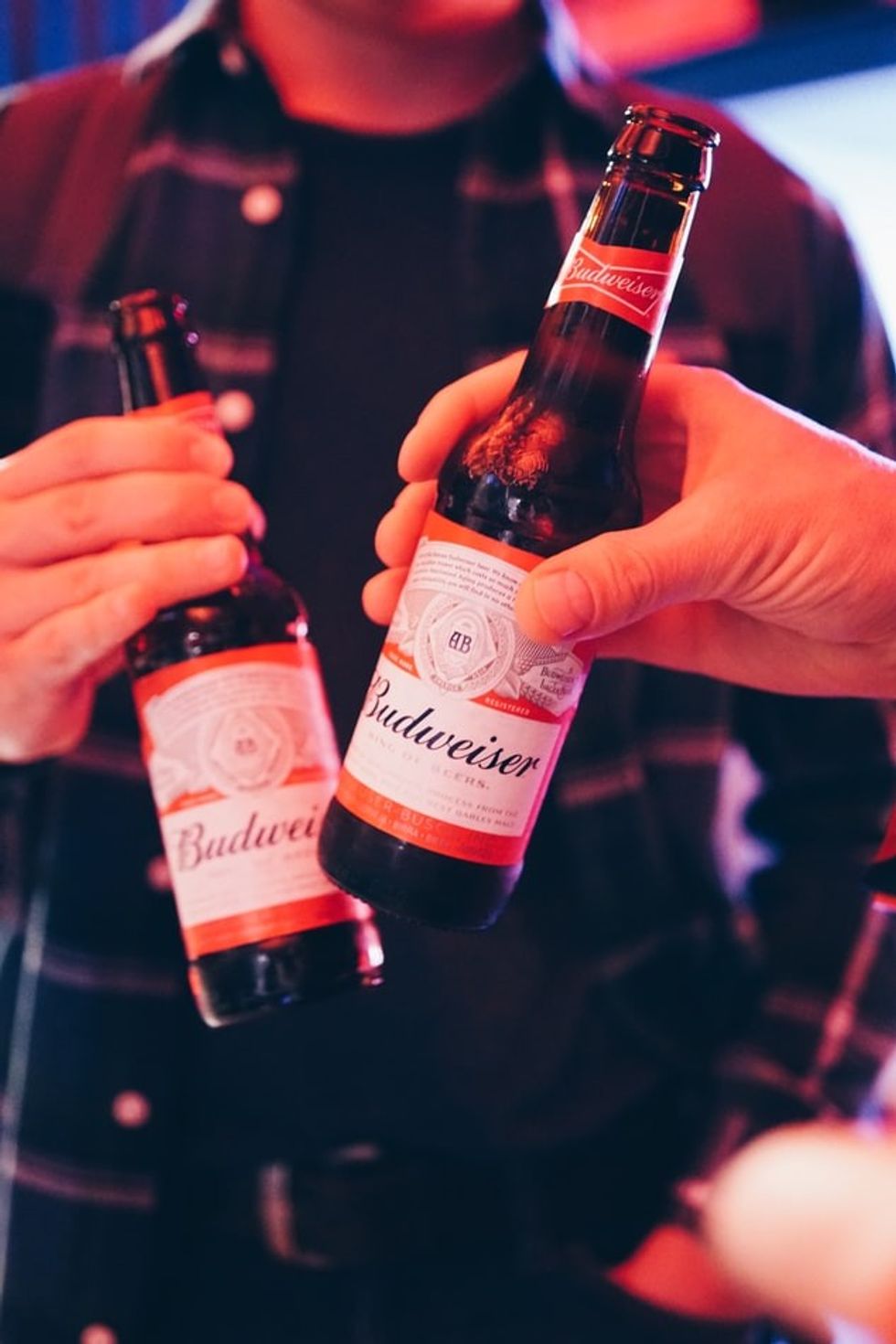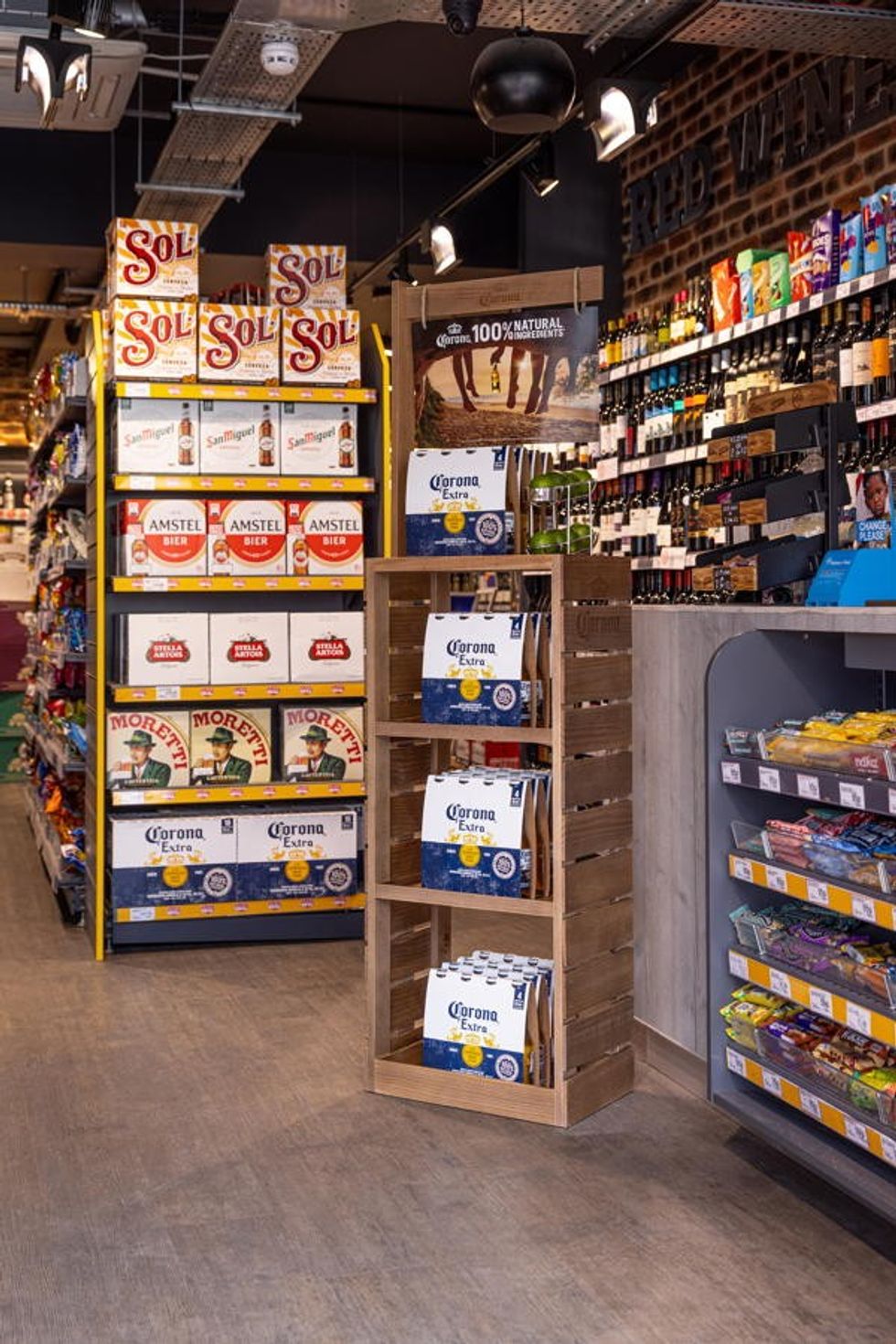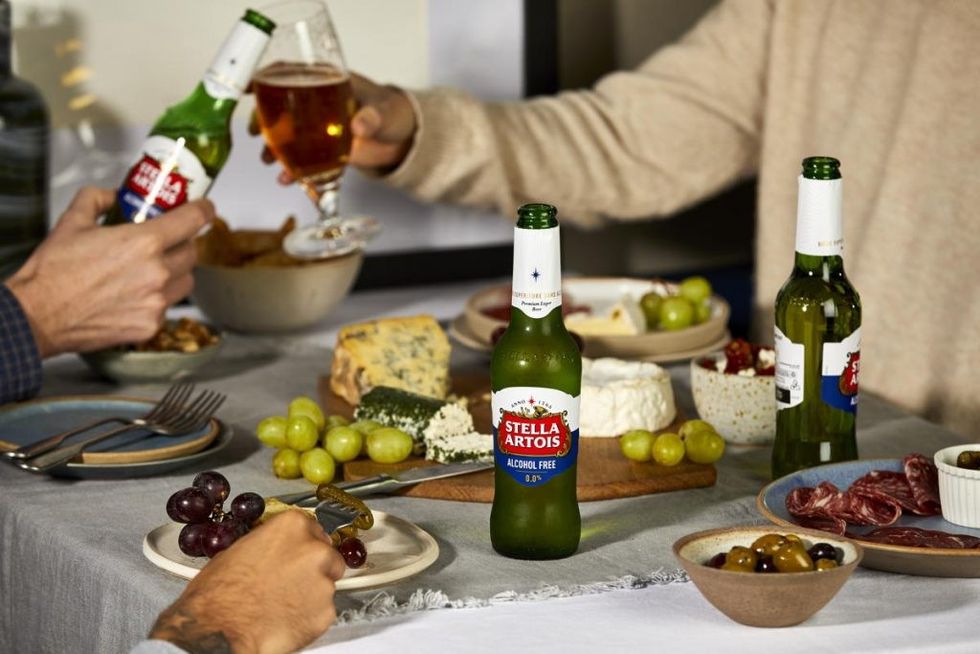Mark Wingfield Digby arrived at Budweiser Brewing Group UK&I in the depths of the third and most severe lockdown back in February. He had already worked at AB InBev for over 15 years (“I’m a lifer” he says, “I started in February 2005, in a graduate position straight out of university”), holding senior roles across the off-trade, on-trade, category management and trade marketing teams here and on the continent.
Most recently he was On-Trade Sales Director for Europe, based out of Brussels – spiritual home of many great lagers – and arrived back permanently in the UK to take over from Jerry Maguire, who had successfully held the fort during the chaotic early months of the pandemic, when the disruption brought about by the close of the hospitality sector meant a complete re-basing of production and supply from on- to off-trade.
Now, as its new Off-Trade “field marshal”, Mark will be responsible for accelerating off-trade sales across Budweiser Brewing Group’s super-strong portfolio which includes Budweiser, Bud Light, Corona, and Stella Artois.
“I started in an off-trade field sales team,” says Mark, explaining how he is definitely not just a denizen of the executive floor. He remembers driving around supermarkets and shops, “Checking out brands were looking great on the shop floor and negotiating additional display space, that kind of stuff.” Later, he started moving into head-office positions, as the UK business morphed from Interbrew to InBev, then to AB InBev. “And of course, we acquired Modelo, and then eventually, SABMiller as well. So the business evolved a lot, a huge amount over the time that I've been there.”
Mark is intimately familiar with the retail side of the beer trade. “My career’s very been mostly off-trade,” he says, “but effectively after we did the deal with Modelo we had grown and were distributed by lots of different people all over the world. And so my job was to transition the brand over into the ABInBev portfolio and build the commercial plan to launch the brand as our brand in 2015. So that's quite a good example of sort of working across lots of different commercial functions to build a strategic plan and across both on-trade and off-trade.”
By the beginning of 2020, working in Europe and commuting from the UK, Mark was leading the on-trade part of the business from a strategic perspective in the Belgium HQ – “Which was great and exciting, but we hadn't anticipated COVID at that stage. So a lot of my job last year became managing the crisis, I would say.”
Home again, home again
Was it the pandemic, then, that brought him back to the UK?
“Everybody had shut down,” he recalls. “Everybody was trying to work out how we support the trade, how we help pubs reopen in a safe way, what the new future digitization in an on-trade environment, post-pandemic looks like. It actually was very exciting because we were able to really connect with teams around a lot of key priorities in quite a nice way.It was exciting to come back. It was like coming home, but I don't know whether I would described it as a relief.”
There was a complete reversal of fortunes, from pubs suddenly selling nothing, to the retail sector – and especially the independent channel – selling more than ever and struggling to lay hands on supplies to keep up with demand. How did Mark experience that battlefield?
“I was obviously very focused on the on-trade last year, and in that instance, it's how do you react to a situation where you're no longer selling any beer.From an off-trade perspective here in the UK – and I wasn't here – it was the flip side of that.”
He says that the remarkable off-trade sales have been sustained into this year, with the help of the extra-long post-Christmas hospitality shut-down.
“I don't think we expected there to be such growth,” he says,“and we didn't know that the on trade was going to close again, didn't know the extent of the restrictions that we experienced in Q1. But the [off-trade] category has been growing pretty much every week since the start of the year.”
Mark views off-trade sales currently as unprecedented. “You think back to periods we've had of real peak demand in the past, for example the 2018 World Cup, where England did so well and the weather was amazing, and we were seeing a lot of growth then. We're eclipsing that now, week after week, just as a result of changing consumer behaviour since the new restrictions came at the start of the year.”
The business is responding brilliantly to demand but it is still a shock, and Mark says that his biggest task is “just to get our heads around how sustainable this growth is going to be and make sure that we're ready for that. But we expect it to continue, to be honest with you.”
He says that Q1 finished around +37 per cent up on the same time – almost completely pre-pandemic – last year, with 211 million additional sales in the off trade. Mark sees this continuing even after the slow, staggered re-opening of pubs through mid-June.
“If people can only meet outside,” he says, “the first time they can reconnect for a long time, they will grab a four pack of beer on their way to someone's home, ideally chilled, and they'll sit in the garden, and that will be their first chance to reconnect.”
He believes it remains to be seen just how comfortable people will be at the pub if they've been vaccinated just once or maybe not been vaccinated at all: “We expect in-home consumption to continue as a very relevant thing for people and we expect growth to continue throughout Q2.”
Last orders?
In America, something like 110,000 restaurants have closed permanently, a sixth of the sector. Perhaps a third of British pubs might also find it too expensive to reopen, having had already to pour oceans of beer away twice. And landlords are carrying a lot of debt. If the pubs aren't full and jumping, it's going to be very difficult for them to trade at all. Despite the predictions, though, Mark remains optimistic about the on-trade.
“I think the on-trade will survive OK,” he says. “It is, very, very difficult to overestimate how important pub culture is to British people. Not all pubs are opening straight away and I think that will contribute to the [off-trade growth] that we expect to see continue, but I don't think this is the end of the British pub. I think it will bounce back, I think it will be extraordinarily resilient. Some pubs will close, but some pubs were closing before.”
What Mark sees as a gift for both the on-and off-trade is the upcoming warmer weather crammed with a sumptuous calendar of sport tailored for beers and BBQs.
“Certainly from an activation perspective we're starting with the Euros and then Wimbledon coming through. So there's a lot of reasons why people will be at home and there'll be a lot of new drinkers out there watching the games. We know what a massive thing football is for beer consumption.”
And the fun doesn’t end there, in a year when the country is still in enthusiastic recovery from the pandemic but staying closer to home than usual.
“In Q3 you've got this summer of staycations and still more sport happening. You've got the [British] Lions story and the Olympics. If people can't go abroad in in August, I think that's going to be massive as well,” he enthuses. “I’d say print out the calendar or put the summer sport poster on your wall and really be tuned into it because you know when there's a game people buy beer!”
The optimistic narrative continues when Mark is quizzed over Brexit complications, and answers that after a very few supply issues (nothing compared to pandemic interruptions), the beer is flowing freely, helped by the fact that all the barley for AB Inbev’s supplies are now grown in the UK thanks to its “Bud Farmers” strategy, whereas prior to 2014, 100 per cent had been imported. Today UK 300 farmers grow 40,000 tonnes of barley annually for Budweiser on over 6,000 hectares of arable land.
“Because most of our ingredients and most of the beer that we sell is produced here, we aren’t so impacted,” says Mark. “We have a few skus we import from Germany or Belgium and in January we had a few products held up at the ports, but everything else came through fine. Brexit was managed reasonably well.”
On the brandwagon
Budweiser Brewing Group’s brands strike a dominant chord in UK beer, with Budweiser and Bud Light, Stella Artois and Corona in every single chiller in the land. The brands are strategized as global assets, which implies a lot of careful positioning and identity-crafting.
“We have a big focus in the UK on what we call our global brands,” says Mark, “and over a period of time they have been driving a lot of our growth.Stella Artois remains the most valuable core brand last year and we know that Stella is massively important to independent convenience stores. Budweiser is growing sales ahead of the category at +29.8 per cent year on year, and is now the second most valuable beer brand in convenience.”
He says that Budweiser has been a massive success story in the convenience channel for the past five years, as the premiumisation trend has embedded itself with UK consumers. “Corona has really grown both volume and value at double the rate of the total category across the course of 2020,” he adds.
It is those brands that will continue to be a huge part of the brewer’s 2021 plans, along with Bud Light, which is now the official beer of the England football team for the Euros and has just launched its jaunty “Boxheads” promotion – “one of the most innovative and exciting trade activations we've had for a long time” –to help get everybody more involved with the upcoming Euros tournament.
This is all is good news for independents, but the multiples are competitors as much as the on-trade, so what would Mark recommend convenience retailers do to increase their share of the market?
“I would encourage your independent retailers to really connect with the opportunity they have in Q2 for all the reasons we discussed,” he says.“The first thing I would say is, be really close to your community and understand how people, your shoppers, people in your area are behaving as [lockdown] restrictions are liftedand as we move into the summer. Soif you're near a park or a beachyou can expect people to be using your shop a lot to pick up your chilled beers ratherthan looking for a beer garden. Instead they will go sit and have a picnic, grab a beer and reconnect with people.”
He says it is important to have the right packs, chilled, as well as having the right availability and“being super cognizant of the weather forecast. And if we see sunny weather I think it's going to be pretty critical to make sure you’re very well stocked on key beer lines.”
It is not only the weather and the outdoors that are set to increase the demand for beer – it is also the change of habits that has developed over the past year, with the balance between in-home and hospitality being permanently altered to an extent now people have accustomed themselves to cooking and entertaining indoors.
“Those occasions that previously have been shared between in-home and the on trade might skew a little bit more to in-home. For sure we have seen big part of the drive of the last 12 months in the beer category is beer being consumed with meals.”
The summer season will tend to cement that association despite hospitality reopening, thinks Mark.
“Independent retailers can tap into the fact that that’s how people will continue to shop – especially with barbecues becoming a massive thing now people can reconnect outdoors,” he says. “So having the right food products, encouraging people to buy snacking products, food and trade up, I think beer can be a really nice anchor to some of those shopping missions. I think barbecues meals at home with beer as an anchor within those baskets, I think could be massive.”
Beer is indeed more massive than ever, but coming upon the inside rail are challengers aimed at a younger generation with a sweeter tooth and a different self-image. How is Mark finding the competition to beer from categories such as hard seltzers and wine in cans, which seem especially appealing to younger females?
“Seltzers have become a very big thing in America,” replies Mark, “and it has taken a bit from light beer but also from spirits and cocktails and kind of what we would call like a ready-to-drink alcohol category. So it's something that we think could become very big here as well, with younger consumers that are more conscious of calories and seeking maybe slightly sweeter flavours or less bitter flavours.”
It is still small here, but the growth potential if it tracks anything like America is “enormous”, says Mark, but he sees it as an incremental opportunity.
“We definitely think hard seltzers could be an opportunity to bring people into our brands. We've got Mike’s [Hard Seltzer brand], which is doing very, very well as one of the most highly-penetrative brands in the category driving great repeat rate, which is what we look at very closely as a sign of an NPD that can be successful.”
Bud Light seltzer is also getting a big launch now from Budweiser Brewing Group UK&I.“We think is a great piece of positioning because Bud Light is very much directed towards younger consumers anyway. When we launched Bud Light, the insight there was that we wanted to bring a standard lager with the market that was kind of relevant and connected to the younger consumer, where maybe they didn't feel connected to some of the alternatives.”
It's also going to be the official seltzer of the England soccer team: “The way we are going to activate Bud Light sponsorship is very much with the family, so Budweiser will be relevant to that and we'll have we'll have England football branding on the Budweiser cans and also the Bud Light cans so it will all be very connected from a Bud family perspective.”
NPD PMP BBG
This year has been talked about as the year of the PMPs as we emerge from lockdown with half the nation feeling poorer and looking for value. It’s especially relevant to the convenience channel, which levels up via PMPs against cheaper competitors – so will BBG deliver for the channel?
“Last year was a challenge for a lot of brewers,” says Mark. “When retailers weren't able to get PMPs, they missed them a lot. So we really underline the importance of the PMPs in this channel, and we’ll be bringing out a new suite of packs, including a single-can PMP on Stella Artois. It's a key part of our strategy.”
He says to “expect massive demand over the next quarter,” and predicts convenience to grow faster than the total off-trade as the spontaneous shopper mission becomes much more relevant now people can reconnect: “Expect the demand to be to be very dynamic, make sure you understand your best-selling products and ensure you have availability, and stay close to the weather forecast. Beer over the last 12 months has been such a huge part of total FMCG growth and leading so much growth that I just encourage retailers to recognise the importance that beer will have within their store over next three to six months and make sure they're allocating the appropriate space.”

In conclusion, Mark believes that we are in for a record-breaking year “for sure”. Q1 has smashed records and “we see no sign of it slowing down. I think you just need to get ready for extreme demand.”
Longer term, Budweiser Brewing Group UK&I is concentrating on its strategic management of a brand portfolio that is seeing tremendous growth, significant development of NPD and even completely new types of drink – and it’s an international, coordinated vision.
“Our portfolio – Corona, Stella Artois and Budweiser– is amazing, and having Bud Light in there as well there as well is great,” he sums up, adding that the B2B side of the business is also being transformed by the increases in retail sales.
“I texpands into how we partner with some of our biggest customers to help them develop. What does B2B look like for wholesalers in the future? How can we support them on a digital transformation that we expect to see across the whole off-trade landscape?”
Mark recalls that a lot was learned from last year’s disruptions. “As a result,” he says, “we added more brewing capacity and will add still more this year. We will have an additional three million hectolitres of capacity to brew in the UK, which translates to another 630 million pints.
A period is now beginning where investments are really beginning to pay off. “It's been a competitive advantage for us over the last three months, and we're expected it to continue to be a competitive advantage for us going forward. We also learned a little bit about how to work with our customers, and our objective is to have our beers available in every shop in the country,and a big part of that is to work very closely with our customers on their forecasting to ensure we have a steady, consistent supply going into the customer base.”








